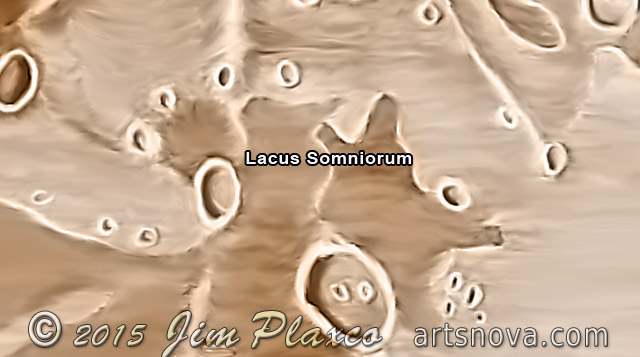Space Art, Lunar Bases, and Space in Chicago

Lacus Somniorum, Moon
Did you ever see that movie Sybil with Sally Field as the multiple personality woman? That's me. Only I'm not a woman and it's not multiple personalities — it's multiple interests. Two interests that are obvious to people who know me are digital art and space — both of the astronomical variety and the space exploration variety.
My multiple competing interests — not to mention my interests in photography (see Jim Plaxco Photography), a wide variety of computing topics, and an interest in economics (my B.S was in Economics) — serve to limit the amount of time I can devote to each individually. In fact I'd say that I frequently find myself the victim of thrashing — an old computer science term describing the sub-optimal performance of a computer when it spends too much time switching between tasks.
It is much the same with my art. I have an interest in a variety of artistic subjects as well as creating art using a variety of stylistic approaches. I really chafe at the traditional advice given to artists that they should pick one subject and one style and stick to it. Where is the intellectual and creative fun in that? I understand how the one subject-one style approach works well for branding but why limit your creative ventures just so you can be more marketable and identifiable? In the acting profession that's known as being typecast.
One recent activity of mine that neatly joined my interests in art and space was serving as a judge in the National Space Society's 2015 International Student Art Contest (see NSS 2015 International Student Art Contest). We finished judging the submitted art last Friday. It took us a good number of hours to go through the 85 submitted works of art. Our first task was to categorize the art and determine whether or not each submission met the contest guidelines. The rule that all submitted art must feature one or more people doing something in a space setting disqualified a number of submissions.
The thorniest issue was regarding that of realism and led to the most intense debate between the judges. Some wanted to establish higher standards for the quality of the art that would be accepted. I argued that since this art contest was marketed as a contest for students and had entries from sixth grade through college, it was not appropriate to expect a sixth grader to produce artwork of the same caliber as that of a college student. On the whole, my approach won out.
One of the stipulations for the art contest was that if the judges felt that none of the submitted art was worthy of being awarded a prize then none would be given. Fortunately I can say that we did award several prizes. However, because the contest results have not yet been announced I can say no more on this subject.
On another space note, I've also been spending more time than planned taking the Introduction to Aerospace Engineering: Astronautics and Human Spaceflight online class from EDX.ORG. The class is being taught by MIT Professor Jeffrey Hoffman, a former NASA astronaut who made the trip to space five times on NASA's Space Shuttle (Hoffman was the first astronaut to log 1000 hours on the Shuttle). My motivation in taking this class was to refresh old knowledge and hopefully pick up some new knowledge.
In one of my roles as President of the Chicago Society for Space Studies, I do a variety of educational space development presentations so a good understanding of the various issues is critical. It was in this role that I spoke a couple weeks ago at Loyola University as a part of the Junior Science and Humanities Symposium. The title of my presentation was From Camp Century to the Moon and in this presentation I emphasized the future commercial opportunities of lunar development (neatly combining my interests in space and economics). The “Camp Century” in the title of my talk is a reference to the nuclear powered "city" the U.S. Army built under the Greenland ice outwardly to do science and learn to live and work in arctic conditions — but secretly a part of Project Iceworm. I use Camp Century in my presentation due to the similarities it has to a lunar base. On a related note, my next space to-do is actually tonight when I'll be doing a shortened version of this presentation for the Rotary Club of Arlington Heights IL. I'm willing to bet that having someone speak about the commercial development of the Moon is rather out of the ordinary for them. We'll see.
The Illustration: Lacus Somniorum, Moon
The illustration for this post is a small section of a digital painting I did of the Moon. This particular art project of mine was inspired by a painting of the Moon done in 1875 by astronomer/artist Étienne Léopold Trouvelot (December 26, 1827–April 22, 1895) whose work I greatly admire. At some point I do plan on adding this work, as well as several other works of lunar art, to my Moon Art Gallery.
The region shown in the illustration is that of Lacus Somniorum (Latin for Lake of Dreams), an irregular plain near the Moon's northeastern limb. Specifically it is at selenographic coordinates 38 degrees north and 29 degrees east. With a diameter of 384 kilometers, it is the largest "lacus" on the Moon.
| Return to the Blog Index | This entry was posted on Wednesday, April 1st, 2015 at 10:05 am and is filed under National Space Society, Space Art, Space Exploration.